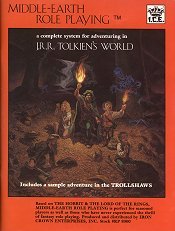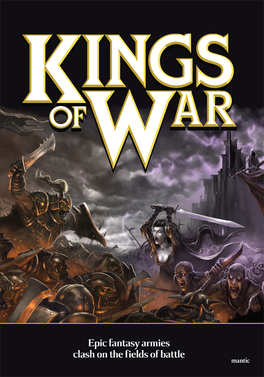
Gondor is a fictional kingdom in J. R. R. Tolkien's writings, described as the greatest realm of Men in the west of Middle-earth at the end of the Third Age. The third volume of The Lord of the Rings, The Return of the King, is largely concerned with the events in Gondor during the War of the Ring and with the restoration of the realm afterward. The history of the kingdom is outlined in the appendices of the book.

Middle-earth Role Playing (MERP) is a 1984 role-playing game based on J. R. R. Tolkien'sThe Lord of the Rings and The Hobbit under license from Tolkien Enterprises. Iron Crown Enterprises (I.C.E.) published the game until they lost the license on 22 September 1999.

Games Workshop Group is a British manufacturer of miniature wargames, based in Nottingham, England. Its best-known products are Warhammer Age of Sigmar and Warhammer 40,000.
In J. R. R. Tolkien's novel The Lord of the Rings, the Battle of the Pelennor Fields was the defence of the city of Minas Tirith by the forces of Gondor and the cavalry of its ally Rohan, against the forces of the Dark Lord Sauron from Mordor and its allies the Haradrim and the Easterlings. It was the largest battle in the War of the Ring. It took place at the end of the Third Age in the Pelennor Fields, the townlands and fields between Minas Tirith and the River Anduin.

In J. R. R. Tolkien's high fantasy The Lord of the Rings, Harad is the immense land south of Gondor and Mordor. Its main port is Umbar, the base of the Corsairs of Umbar whose ships serve as the Dark Lord Sauron's fleet. Its people are the dark-skinned Haradrim or Southrons; their warriors wear scarlet and gold, and are armed with swords and round shields; some ride gigantic elephants called mûmakil.

The Lord of the Rings: The Third Age is a 2004 role-playing video game developed by EA Redwood Shores for the PlayStation 2, Xbox and GameCube. A turn-based tactics version of the game was developed for the Game Boy Advance by Griptonite Games. The game was published on all platforms by Electronic Arts, and released worldwide in November 2004.

The Lord of the Rings: The Battle for Middle-earth is a 2004 real-time strategy video game developed by EA Los Angeles for Microsoft Windows. The first part of the Middle-earth strategy game, It is based on Peter Jackson's The Lord of the Rings film trilogy, in turn based on J. R. R. Tolkien's original novel. The game uses short video clips from the movies and a number of the voice actors, including the hobbits and wizards. It uses the SAGE engine. The sequel, The Lord of the Rings: The Battle for Middle-earth II, was released on March 2, 2006.

Middle Earth Strategy Battle Game, previously marketed as The Hobbit: An Unexpected Journey Strategy Battle Game, The Hobbit: The Desolation of Smaug Strategy Battle Game, The Hobbit: The Battle of Five Armies Strategy Battle Game and The Lord of the Rings Strategy Battle Game, is a tabletop miniature wargame produced by Games Workshop. It is based on The Lord of the Rings film trilogy directed by Peter Jackson, and the book that inspired it, written by J. R. R. Tolkien.

The Lord of the Rings: The Battle for Middle-earth II is a 2006 real-time strategy video game developed and published by Electronic Arts. Being second part of the Middle-Earth strategy game, it is based on the fantasy novels The Lord of the Rings and The Hobbit by J. R. R. Tolkien and its live-action film series adaptation. It is the sequel to Electronic Arts' 2004 title The Lord of the Rings: The Battle for Middle-earth. Along with the standard edition, a Collector's Edition of the game was released, containing bonus material and a documentary about the game's development.

The Lord of the Rings: War of the Ring is a 2003 real-time strategy game (RTS) developed by Liquid Entertainment and published by Sierra Entertainment, a subsidiary of Vivendi Universal Games. Set in J. R. R. Tolkien’s fictional Middle-earth, it expands upon the events of the War of the Ring as told in his fantasy novel, The Lord of the Rings.
All at Sea is a naval ruleset for Games Workshop's miniature wargame The Lord of the Rings Strategy Battle Game. The official rules were a modified version of the Warhammer Boat rules, adapted by Nick Davis and first presented in Games Workshop's White Dwarf magazine.

War of the Ring is a strategy board game by Roberto Di Meglio, Marco Maggi and Francesco Nepitello, first produced by Nexus Editrice (Italy) and currently published by Ares Games.

Rick Priestley is a British game designer and author mainly known as the creator of Warhammer miniature wargame.

Games of Middle Earth is a trilogy of board games published by Simulations Publications, Inc. in 1977 that are all based on the epic fantasy novel The Lord of the Rings by J. R. R. Tolkien. It was a bestseller for SPI even before its publication, and remained at or near the top of SPI's Top Ten list for two years.
Aragorn is a fictional character and a protagonist in J. R. R. Tolkien's The Lord of the Rings. Aragorn was a Ranger of the North, first introduced with the name Strider and later revealed to be the heir of Isildur, an ancient King of Arnor and Gondor. Aragorn was a confidant of the wizard Gandalf, and played a part in the quest to destroy the One Ring and defeat the Dark Lord Sauron. As a young man, Aragorn fell in love with the immortal elf Arwen, as told in The Tale of Aragorn and Arwen. Arwen's father, Elrond Half-elven, forbade them to marry unless Aragorn became King of both Arnor and Gondor.

Kings of War, is a tabletop wargame created by Mantic Games.
Alessio Cavatore is a game designer.
The geography of Middle-earth encompasses the physical, political, and moral geography of J. R. R. Tolkien's fictional world of Middle-earth, strictly a continent on the planet of Arda but widely taken to mean the physical world, and Eä, all of creation, as well as all of his writings about it. Arda was created as a flat world, incorporating a Western continent, Aman, which became the home of the godlike Valar, as well as Middle-earth. At the end of the First Age, the Western part of Middle-earth, Beleriand, was drowned in the War of Wrath. In the Second Age, a large island, Númenor, was created in the Great Sea, Belegaer, between Aman and Middle-earth; it was destroyed in a cataclysm near the end of the Second Age, in which Arda was remade as a spherical world, and Aman was removed so that Men could not reach it.
Mantic Games is a British miniatures and board game publisher, based in Bulwell, Nottingham, UK.
War of the Ring is a 1976 board wargame published by Fantasy Games Unlimited. It is based on the Middle-earth works of J. R. R. Tolkien.














